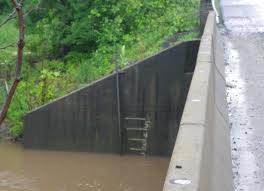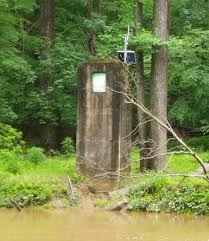Introduction
Natural streams can be very dynamic. Rivers in canyons have often risen several feet in an hour or two turning a nice leisurely run into menacing flood conditions. Rivers that really neck down like Little Falls may look placid near the put-in and downright scary when the river necks down over a drop downstream. Many rivers start with a reasonable rate of descent but may tilt severely downhill later in the run. As the stream picks up gradient, rapids often become more continuous and the ability to recover from a swim becomes much more challenging. Waves and eddies form when water has to work it's way through river bed obstructions. We typically use waves and holes to assist us in navigating challenging rapids.
Flow Volume
River levels are measured in either CFS (Cubic Feet per Second) or the Randy Carter Gauge method - feet/inches at a given point on a river. CFS is a much more reliable measurement but more difficult to implement.
 Randy Carter Gauge The Randy Carter gauge typically marks ZERO as the lowest enjoyable running level - everyone has their own opinions.
Randy Carter Gauge The Randy Carter gauge typically marks ZERO as the lowest enjoyable running level - everyone has their own opinions.
 Government Gauge Here is an example of a typical government automated gauge.
Government Gauge Here is an example of a typical government automated gauge.
Here is a nice article that describes how river flow can be calculated in CFS: Measuring Stream Flow.
There are a number of excellent resources for determining water levels:
American Whitewater River Database
This site is one of the best for looking up river conditions in your area. It doesn't hurt to check upstream runs as well to avoid having the river rise too rapidly.
USGS River Stage Forecast
I really like this web site for more detailed information such as water temperature, historical flow, and of course what is the stage forecast for this weekend.
MCC River Levels & Weather
The Monocacy Canoe Club has compiled a great list of river gauge web sites.
The key points to remember are study runs you plan to lead trips on. Know what is a reasonable water flow and monitor before and during the run to ensure safe passage.
Gradient-Elevation Changes
Gradient along with flow volume are great indicators for river difficulty. Both contribute to a boating term called "Push". Beginner and novice whitewater runs are typically in the 5' - 20' per mile rate of descent. It is quite hard to imagine any class II streams that drop at a rate of 100' mile. Even though the overall drop of a run may seem reasonable if the gradient (rate of descent) is quite uneven, you probably will encounter falls or dangerous drop you will need to portage. A popular novice run is Muddy Creek in Pennsylvania. In the middle is a very steep drop that even expert boaters carry. Web sites and guidebooks are your best resource for planning trips and understanding known hazards you need to deal with.
Flow Rates And Current
River current changes considerably on whitewater streams and in large open bodies of water, especially on the ocean. When the river is wide, the current is pretty slow. If you flip and swim it is easy to swim and tug your boat to shore. When the river necks down, the current picks up significant speed. Water can start piling up on river banks that you probably want to stay away from. Picture a weight at the end of a rope. As you swing this rope around you, the weight has to move a much larger distance than your hand. The same is true on a river. Current is much faster on the outside of river bends.
Ocean currents can be quite deceptive. Some areas can develop rip tides which can be rather forceful and dangerous to swimmers. Here is a good set of articles on this phenomena: Rip Tides.
River current doesn't always flow downstream. When water drops over ledges and around large boulders, eddies are formed. Water current at the surface works its way back upstream. Between the eddy and the main current is an eddy line which is well defined at the top of an eddy and far less stable further down the eddy line.
In chutes, water current is typically fastest in the center. Once the tongue runs out, energy is dissipated in waves. Down river racers run on the shoulders of these waves to increase their speed. If they run too far on the side, their boats will slow down considerably since they will have entered slack water formed by eddies.
Power of the Current / River Level
River current in rapids produce an amazing amount of force. A common boating term for this is "Push". Many intermediate boaters find the Cheat Canyon pretty straightforward at 1' on the bridge gauge. Increase the bridge gauge to 3' and the run becomes a nightmare for them. River currents on large bodies of water also need to be taken into consideration when planning how long it will take to paddle a certain distance. If you can paddle 3 mph on a flat lake and you are paddling against a 2 mph current, your net speed is only 1 mph. Fortunately in whitewater, we are typically paddling with the current (at least most of the time).
Water is Heavy!
Many that are new to our sport grossly underestimate the power of water. It isn't unusual for a small stream to flow at 300 CFS (Cubic Feet per Second). One Cubic Foot of water weighs 62.5 pounds. Since pins often occur where the river necks down, a very large portion of the stream's flow is pressing down on the trapped object. Over time, most boaters discover they need to work with the river instead of fighting a losing battle. The AW site's national river database: AW River DB is a great safety tool. It is color coordinated to let you know when your favorite streams are reasonably safe to paddle. River levels may also rise unexpectedly from isolated storms upstream. When paddling isolated runs, we need to pay attention to the overall river level and potentially take off the river when the level is too high for safe boating.
Water is Powerful
Water exerts a great deal of force on objects. The following chart is from River Rescue, 4th Edition - Les Bechdel & Slim Ray:
| The Force of Current | |||
| Current Velocity | Average Total Force of Water (Foot Pounds) | ||
| MPH | On Legs | On Body | On Swamped Boat |
| 3 | 16.8 | 33.6 | 168.0 |
| 6 | 67.2 | 134.0 | 672.0 |
| 9 | 151.0 | 302.0 | 1512.0 |
| 12 | 269.0 | 538.0 | 2688.0 |
The force increases in proportion to the square of the water velocity. Water is heavy as well, it weighs 62.4 lbs per cubic foot (or 8.35 lbs/gal). Figure an average kayak holds 75 gallons without air bags, the total weight is: (75 * 8.35) + 40 (average kayak weight) or 666 Pounds. Now you can understand why we insist on paddlers installing air bags in their boats.
Constrictions
Rapids are formed in a number of ways which makes them so interesting. Here is a trick question. If a run is flowing at 1,000 CFS in the pool above a rapid which is 500' wide, what is the CFS in the rapid which is only 100' wide? Believe it of not, it is still 1,000 CFS. That same 1,000 CFS is going to be a great deal more powerful though and you better be prepared for this change. Chances are pretty decent that you can paddle back against the current in the pool above. Good luck trying the same in the rapid. Since the flow (amount) of water is the same, the current is going to be much faster in the rapid.
Conclusions
Since water currents are both heavy and forceful, how does that impact the typical whitewater boater?
- Install Floatation - If you and your boat get separated on a fast moving stream, the water you displace will make recovering your boat your boat faster and safer.
- Work with the current, try not to fight it. A great way to unsterstand this principle is doing attainment drills.
- Obey the "Safe Eddy Rule". Never stand in moving water deeper than your knees. As you can see from the table above, a foot entrapment is going to be challenging to escape.
- Stay off rivers in flood stage. The AW site color codes these as purple in their river database. Rivers in flood escape their river banks and weave through trees and brush - always a deadly combination for whitewater boaters.
- Monitor river levels. If your run is rising quickly, make a determination for what level is no longer safe and pull off immediately when the river reaches that level.
- Fast current requires setting a steeper boat when performing ferry maneuvers. Using waves to assist in ferrying is really helpful. You will get to practice this technique on the second day in the Feeder Canal.
Here is a short article from the ACA on the effects of wind, waves, and water by Mike Aronoff: Wind, Waves, Current.
